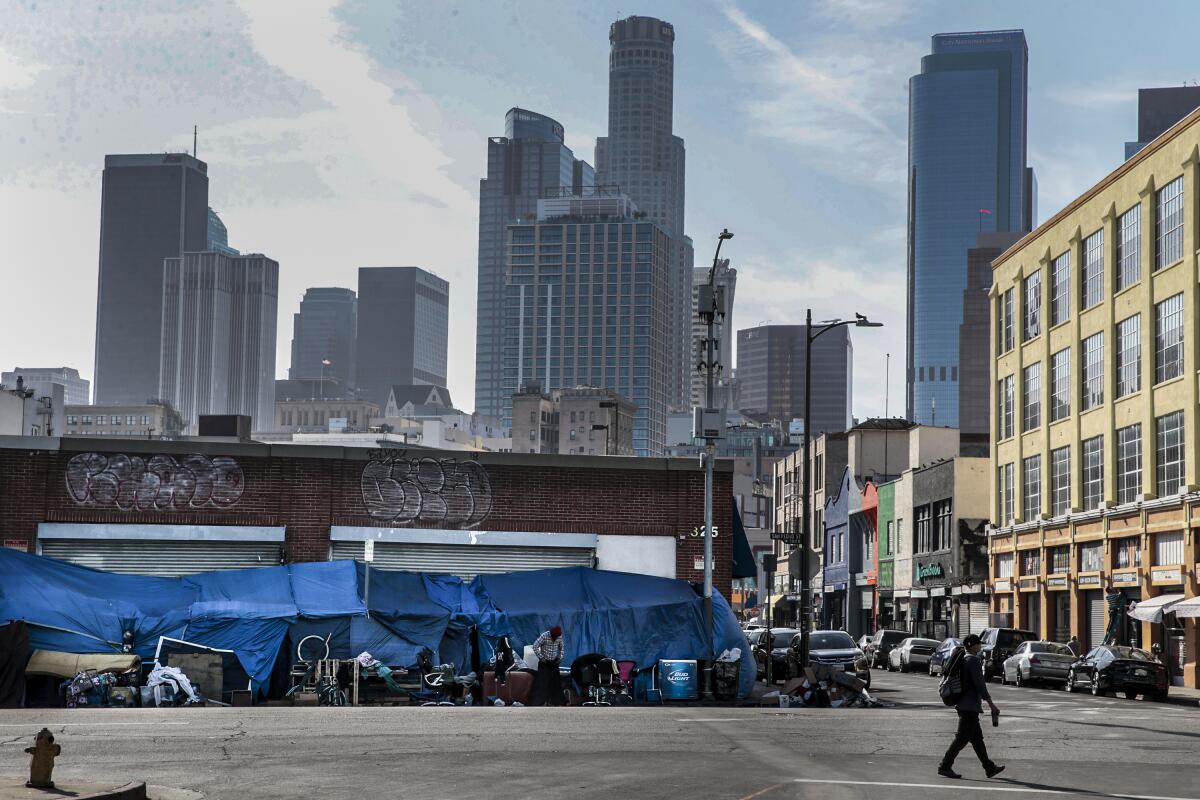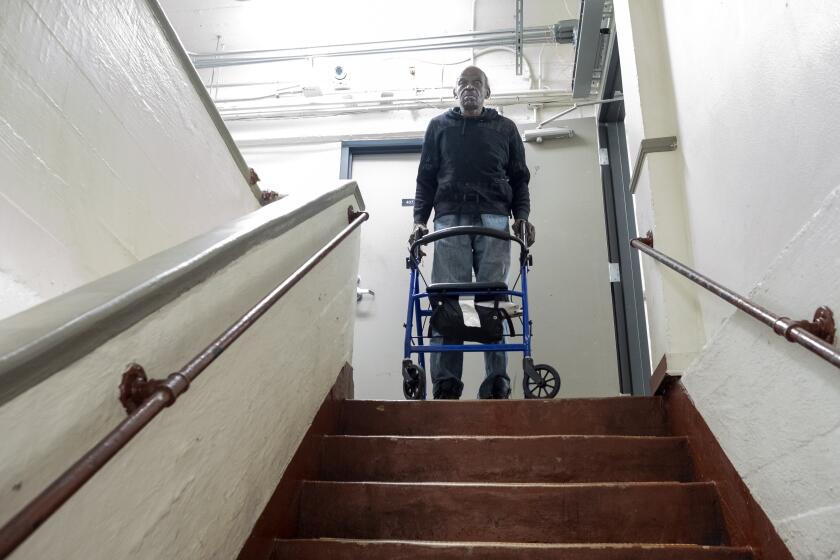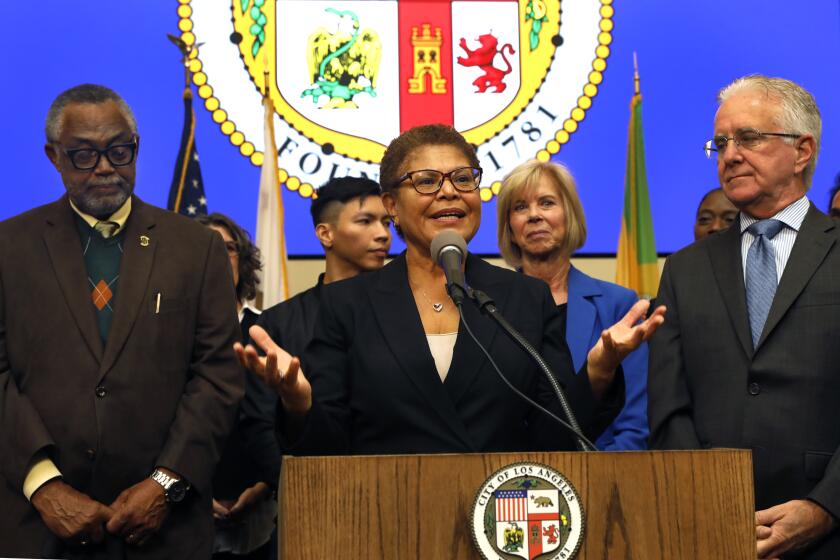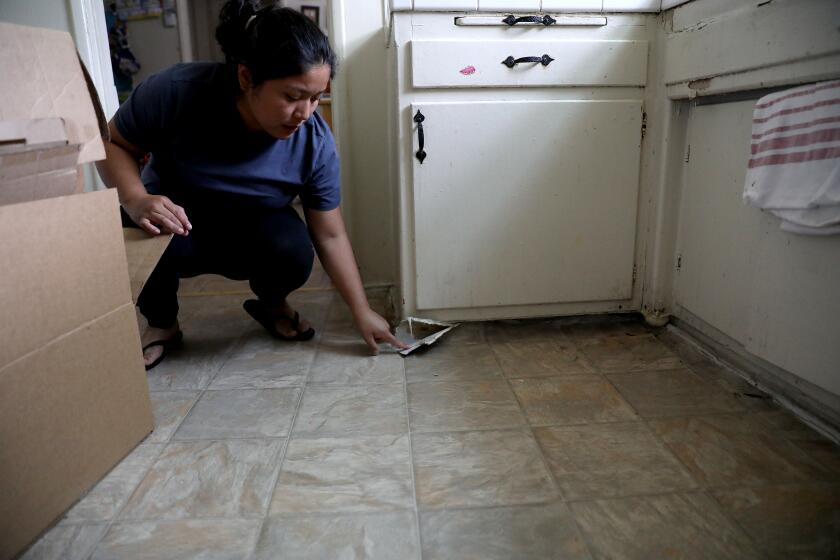One of Skid Row’s largest housing providers faces financial implosion

Skid row’s flagship owner and operator of subsidized housing is on the verge of financial collapse and seeking a lifeline to keep its doors open for more than a thousand low-income tenants.
Skid Row Housing Trust, a pioneer in the decades-old movement to revive aging downtown real estate as homeless housing, has been working with other housing providers to take over its 29 buildings.
In a series of meetings Tuesday briefing the staff on the organization’s impending changes, interim chief executive Joanne Cordero sought to assure the 165 employees that other philanthropic and housing organizations are stepping in to ensure that their work will continue and that no one will lose their home.
“Everybody is coming together to help figure this out and to support the residents,” Cordero told The Times in an interview.
“They’re not coming to support the trust, they’re coming to support the residents. Nobody has any desire to see any of our housed people become unhoused.”
Several philanthropic groups — including the Weingart Foundation, the Hilton Foundation and Cedars-Sinai — have committed hundreds of thousands of dollars to keep the agency afloat while it works to divest its properties.
Get the lowdown on L.A. politics
Sign up for our L.A. City Hall newsletter to get weekly insights, scoops and analysis.
You may occasionally receive promotional content from the Los Angeles Times.
The demise of Skid Row Housing Trust highlights the vulnerability of the housing model it pioneered.
For more than three decades, the trust has been a mainstay of Los Angeles’ nonprofit housing community, building and managing nearly 2,000 units of single residence occupancy buildings and permanent supportive housing.
“Skid Row Housing Trust is not only an institution in the region for providing much needed housing for people on the margins, it really led in creating a norm of permanent supportive housing,” said Miguel Santana, president and chief executive of the Weingart Foundation, which chipped in $200,000 late last year to help keep the organization solvent. The Hilton Foundation and Cedars-Sinai’s philanthropic arm also donated $250,000 and $150,000, respectively, to help the trust stay afloat in the near term.
“Their footprint in L.A. is significant,” said Santana. “They have been advocates for preserving housing for the people who most need it. So it’s unfortunate that it’s gotten to this point with their finances where they’re not able to maintain the breadth of assets they have.”
But several years of running deficits of as much as $14 million per year, according to their own financial disclosures, left the organization struggling to pay employees and pay basic bills.
In recent years, the agency has pivoted toward new construction, building architecturally striking buildings that enhanced skid row. It has completed three projects with about 250 units, using funding from Proposition HHH, the $1.2-billion housing bond approved by Los Angeles city voters in 2016.
The AIDS Healthcare Foundation has spent tens of millions on pro-tenant causes. Yet elderly and disabled tenants at one of its buildings complain they have spent months at a time without a functioning elevator.
But a portfolio dominated by buildings from the first half of the 20th century became increasingly challenging to support. As maintenance needs outstripped revenue, hundreds of units remained in uninhabitable condition after tenants left, creating a vicious cycle of declining rents. Occupancy at their buildings has dipped to about 78%, Cordero said.
Skid Row Housing Trust was started by a group of activists in 1989 to prevent these buildings from being torn down and turned into office space or less affordable housing. The result was the purchase and renovation of more than a dozen of these residential motels in and around skid row.
Keeping these buildings in good condition and assuring residents had habitable units were difficult and costly propositions.
“You get residents who have some kind of a meltdown, and they destroy their unit,” Cordero said, trying to sum up the challenge of managing these buildings even in the best of times. “And then we figure out how to get them the services they need and then they come back, and they destroy the new unit that they have gotten into, and then they destroy the third unit.”
“These are real issues ... our occupancy level is probably lowest it has been for a long time.”
A series of leadership changes, including three CEOs, and an exodus of talent followed the 2018 retirement of its visionary longtime leader Mike Alvidrez. These left the agency ill-equipped for the type of restructuring needed to keep it afloat. Financial disclosures posted on on their website show the Trust in 2018 had about $21.67 million in revenue and $39 million in expenses.
“It was this constant battle with diminishing resources to figure out what we could do for people who lived in the buildings or worked in the buildings,” one former employee said, speaking on condition of anonymity because they didn’t want to jeopardize relationships in the housing community.
Cordero, who took over as CEO in fall 2022, declined to speak about the trust’s current financial situation or explain the specifics of previous years’ shortfalls. In 2020, though, documents on the organization’s website show that the trust had about $28 million in revenue and $41 million in expenses.
Last summer, the state Housing and Community Development Department and the Los Angeles Housing Department, which both hold notes on the older properties, began filing notices of default, a city housing official said.
By year’s end, the agency’s financial condition reached such a crisis that philanthropic organizations had to step in to ensure it could meet payroll.
Weeks into her tenure as Los Angeles mayor, Karen Bass talks about her focus on homelessness and affordable housing.
The trust’s current leadership resolved that the best way to ensure the stability for the people living in the 29 buildings it owns was to seek out providers who have experience helping vulnerable people who may recently have been homeless to take ownership and manage the buildings. That process began in the last few weeks.
Since then, the agency has been preparing capital-needs assessments to determine what is needed to get each building out of the red and to bundle the profitable ones with the money losers into groups they hope will be attractive to other housing providers.
But Los Angeles officials have already acknowledged the cash flow gap must be filled by public money because the buildings are not likely not attract private capital. Much of this financial support would have to go to renovating and rehabbing these buildings and getting them into better shape, these officials said.
This challenge comes as the city is aggressively trying to expand the supply of interim and permanent housing available to homeless people. Losing units or having them vacant is not tenable, they said.
“I know that we will participate financially,” said Mercedes Marquez, L.A.’s chief of Housing and Homelessness Solutions.
“We are working intently to understand what it is that will be required to stabilize those properties so that they can be transferred to other owners and managed as affordable housing for very low income people.”
Ann Sewill, general manager of the city’s Housing Department, echoed this sentiment saying that some combination of the state and the city — both of which have loaned money to help construct and maintain these building — will likely have to step in. She added that what’s playing out now — the nonprofit housing community coming together to take over management of these buildings — is much better than a foreclosure sale.
“The general idea is that everybody wants to preserve these as important affordable housing assets,” she said.
“We want to help them bring us a workout plan that we can improve and help strengthen.”
Cordero said that there’s interest in nearly all the buildings and that her organization has reached out to a number of affordable housing developers in the region to gauge their interest.
One that is vetting some of the properties is People Assisting the Homeless. CEO Jennifer Hark-Dietz said in an interview that she was unsure of how many of the properties her organization would take.
Nearly 100 tenants at the Chesapeake Apartments in South L.A. have sued their landlord, citing rampant vermin infestation and other serious problems.
“I don’t want to get us into a similar situation, right, because maybe the revenue is not able to meet the needs of the building,” she said.
“I think having multiple providers involved is probably going to be the most beneficial route. So we definitely aren’t looking at taking the entire portfolio. I think it would be a lot for any one entity.”
Stephanie Klasky-Gamer, president and chief executive of L.A. Family Housing, a homeless services and housing nonprofit, said she had been discussing Skid Row Housing Trust’s demise with her board’s real estate committee on Tuesday — partially because it serves as a cautionary for nonprofits like hers, which also own and operate aging buildings.
She said L.A. Family Housing, which mainly works in the San Fernando Valley, is looking into whether they could take over the management and ownership of at least one of the trust’s buildings in North Hollywood.
“They have some of the oldest properties of our industry, and those properties they need to be reinvested in in a significant way,” she said.
“We need to recognize how old a lot of our portfolios are, and how much investment needs to be made into those buildings so that they’re up to the appropriate health and safety standards and so that they don’t bring an organization down.”
More to Read
Sign up for Essential California
The most important California stories and recommendations in your inbox every morning.
You may occasionally receive promotional content from the Los Angeles Times.















